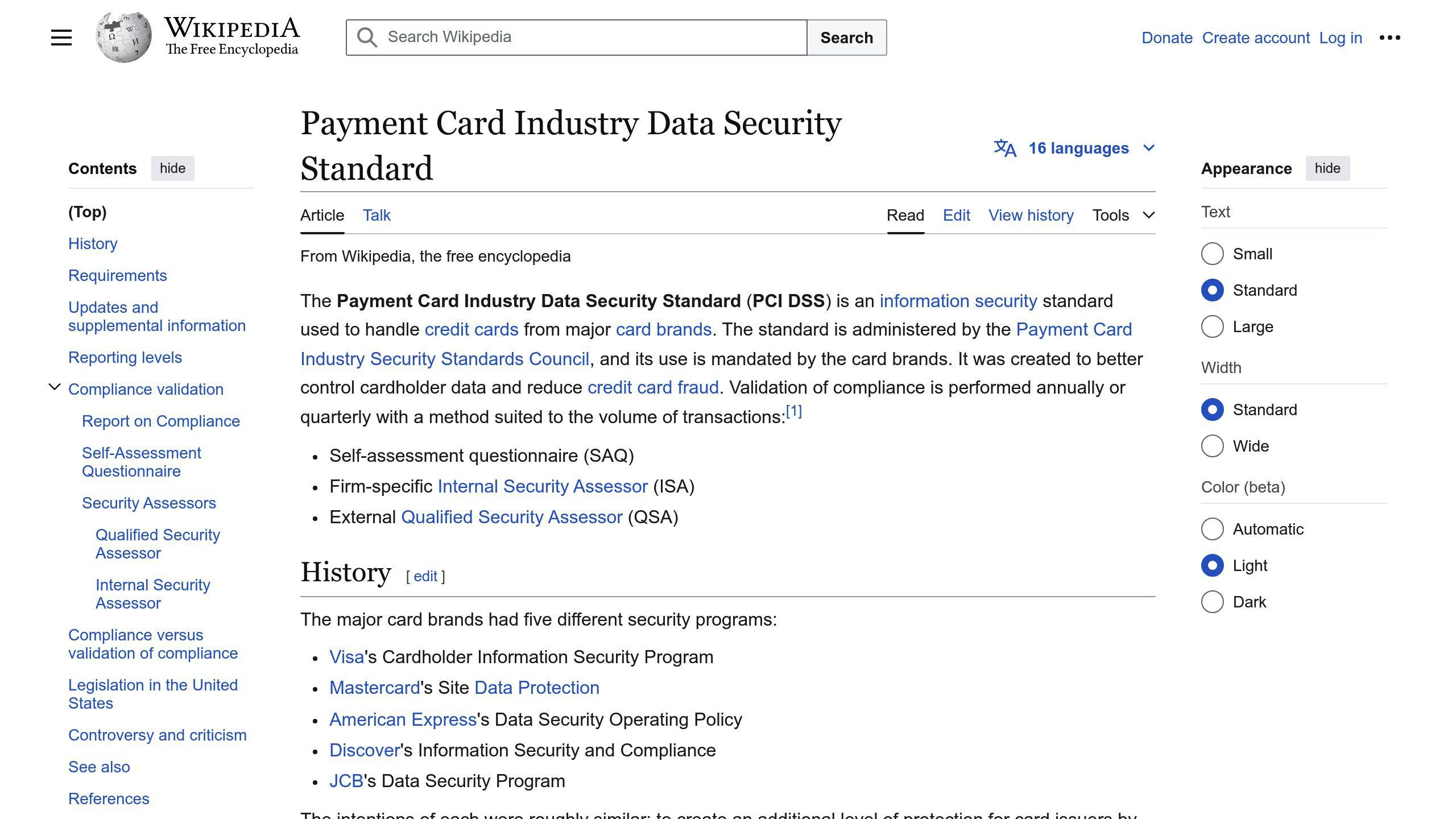PCI DSS (Payment Card Industry Data Security Standard) is a set of 12 requirements that businesses must follow to securely handle credit card data and prevent data breaches. Compliance is mandatory for any organization that stores, processes, or transmits credit card information.
The 12 PCI DSS Requirements:
- Install and maintain firewalls
- Change default passwords and settings
- Protect stored cardholder data
- Encrypt transmission of cardholder data
- Use and regularly update anti-virus software
- Develop and maintain secure systems and applications
- Restrict access to cardholder data
- Assign a unique ID to each person with computer access
- Restrict physical access to cardholder data
- Track and monitor all access to network resources and cardholder data
- Regularly test security systems and processes
- Maintain an information security policy
Compliance Levels and Validation:
| Level | Yearly Transactions | Validation |
|---|---|---|
| 1 | Over 6 million | Internal audit, quarterly PCI scan |
| 2 | 1 million to 6 million | Annual SAQ, quarterly PCI scan (optional) |
| 3 | 20,000 to 1 million e-commerce | Annual SAQ, quarterly PCI scan (optional) |
| 4 | Less than 20,000 e-commerce or up to 1 million real-world | Annual SAQ, quarterly PCI scan (optional) |
Penalties for Non-Compliance:
- Financial penalties ranging from $5,000 to $100,000 per month
- Legal issues and potential prosecution
- Damage to business reputation and loss of customer trust
Continuous Compliance Monitoring:
- Regular vulnerability scans and penetration testing
- Employee training on PCI DSS requirements
- Monitoring tools like SIEM, vulnerability scanners, and compliance management software
Key Takeaways:
- Follow the 12-step PCI DSS compliance checklist
- Continuously monitor and update your compliance program
- Implement a robust compliance program to avoid penalties, protect reputation, and build customer trust
- Seek expert assistance if needed for implementation or guidance
Related video from YouTube
The 12 PCI DSS Requirements

PCI DSS compliance helps protect credit card data from unauthorized access and misuse. The 12 requirements provide a framework for securing cardholder information. Here's a simple overview of each requirement:
1. Set Up and Maintain Firewalls
- Configure firewalls to control network access
- Use firewalls at internet connections and between networks
- Regularly review and update firewall rules
2. Change Default Settings and Passwords
- Change default passwords on systems and software
- Implement strong password policies
- Remove or rename default accounts
3. Protect Stored Card Data
- Encrypt or mask stored cardholder data
- Use secure protocols for data storage and transmission
- Limit access to stored cardholder data
4. Encrypt Card Data Transmissions
- Use strong encryption for data in transit
- Implement SSL/TLS for web transactions
- Ensure encryption for all cardholder data transmissions
5. Use and Update Antivirus Software
- Install and regularly update antivirus software
- Implement a program to detect and prevent malware
- Enable antivirus software on all systems
6. Develop and Maintain Secure Systems
- Follow secure coding practices
- Regularly update systems and applications
- Conduct risk assessments to identify security threats
7. Restrict Access to Card Data
- Limit access to cardholder data to only those who need it
| Requirement | Description |
|---|---|
| 8. Assign Unique IDs | Ensure each user has a unique ID to track their actions and prevent unauthorized access. |
| 9. Restrict Physical Access | Limit physical access to systems and environments that store or process cardholder data. |
| 10. Monitor Access | Log and monitor all access to cardholder data and network resources to detect potential breaches. |
| 11. Test Security Systems | Regularly test security systems and processes to identify and address vulnerabilities. |
| 12. Maintain Security Policy | Develop and maintain an information security policy to ensure all personnel understand and follow security procedures. |
Compliance Levels and Validation
PCI DSS has four compliance levels based on a merchant's yearly transaction volume. The levels determine the validation requirements to maintain compliance.
Level 1 Compliance
- Transaction Volume: Over 6 million transactions per year
- Validation Requirements:
- Annual internal audit by an authorized PCI auditor
- Quarterly PCI scan by an Approved Scanning Vendor (ASV)
Level 2 Compliance
- Transaction Volume: 1 million to 6 million transactions per year
- Validation Requirements:
- Annual Self-Assessment Questionnaire (SAQ)
- Quarterly PCI scan (may be required)
Level 3 Compliance
- Transaction Volume: 20,000 to 1 million e-commerce transactions per year
- Validation Requirements:
- Annual SAQ
- Quarterly PCI scan (may be required)
Level 4 Compliance
- Transaction Volume: Less than 20,000 e-commerce transactions or up to 1 million real-world transactions per year
- Validation Requirements:
- Annual SAQ
- Quarterly PCI scan (may be required)
| Level | Yearly Transactions | Validation |
|---|---|---|
| 1 | Over 6 million | Internal audit, quarterly PCI scan |
| 2 | 1 million to 6 million | Annual SAQ, quarterly PCI scan (optional) |
| 3 | 20,000 to 1 million e-commerce | Annual SAQ, quarterly PCI scan (optional) |
| 4 | Less than 20,000 e-commerce or up to 1 million real-world | Annual SAQ, quarterly PCI scan (optional) |
Merchants must determine their compliance level and meet the corresponding validation requirements to maintain PCI DSS compliance and secure cardholder data.
sbb-itb-8201525
Penalties for Non-Compliance
Failing to comply with PCI DSS can lead to severe consequences, including financial penalties, legal issues, and damage to your business's reputation. The penalties depend on how serious the violation is and your compliance level.
Financial Penalties
Organizations that don't comply may face fines from credit card companies, ranging from $5,000 to $100,000 per month until they become compliant. They may also be responsible for costs like replacing cards, covering fraudulent transactions, and legal fees.
| Non-Compliance Duration | Monthly Fine Range |
|---|---|
| First 3 months | $5,000 - $10,000 |
| 4 to 6 months | $25,000 - $50,000 |
| After 7 months | $50,000 - $100,000 |
Legal Issues
In countries where PCI DSS compliance is required by law, government agencies and regulators can prosecute organizations that violate the requirements, leading to legal consequences. Organizations may also face lawsuits from affected customers or financial institutions.
Reputation Damage
Non-compliance can damage your business's credibility and trust among customers, resulting in a loss of business. The consequences of non-compliance can be severe, making it crucial for organizations to prioritize PCI DSS compliance.
To avoid these penalties, organizations must meet the required PCI DSS standards. By doing so, they can protect cardholder data, maintain customer trust, and avoid the financial and reputational consequences of non-compliance.
Continuous Compliance Monitoring
PCI DSS compliance requires ongoing effort. You must regularly check for security weaknesses and address potential threats. This section explains the importance of continuous monitoring and strategies to maintain PCI DSS compliance.
Regular Vulnerability Scans
Conduct vulnerability scans at least quarterly to identify security weaknesses in your systems and applications. Include both internal and external scans. Finding vulnerabilities early allows you to fix them promptly and prevent security breaches.
Penetration Testing
Penetration testing, or pen testing, simulates a cyber attack on your computer systems, networks, or web applications to assess their security. This testing helps identify vulnerabilities that attackers could exploit and evaluates the effectiveness of your security controls. Conduct pen testing at least annually by a qualified third-party provider.
Employee Training
Train employees on PCI DSS requirements and the importance of compliance. Make them aware of risks and consequences of non-compliance. Regular training sessions and phishing simulations can educate employees and prevent social engineering attacks.
Monitoring Tools and Technologies
Use tools and technologies to streamline continuous compliance monitoring:
| Tool | Purpose |
|---|---|
| Security Information and Event Management (SIEM) systems | Collect and analyze security data from various sources |
| Vulnerability scanners | Identify vulnerabilities in systems and applications |
| Compliance management software | Automate compliance processes and reporting |
Conclusion
Following the 12-step PCI DSS compliance checklist is crucial for safeguarding your customers' sensitive payment data. However, remember that PCI DSS compliance is an ongoing process that requires continuous monitoring and improvement. Stay updated with the latest PCI DSS standards and best practices to maintain compliance and protect your business from potential security breaches.
Implementing a robust PCI DSS compliance program not only helps you avoid costly penalties and damage to your reputation but also builds trust with your customers and partners. If you need assistance implementing the checklist or guidance on specific requirements, consider seeking help from a qualified security expert or PCI DSS compliance specialist.
| Benefit | Description |
|---|---|
| Avoid Penalties | Comply with PCI DSS to prevent costly fines and legal issues |
| Protect Reputation | Maintain customer trust by securing payment data |
| Expert Guidance | Seek professional help if needed for implementation or specific requirements |
Key Takeaways
- Follow the 12-step PCI DSS compliance checklist
- Continuously monitor and update your compliance program
- Stay current with the latest PCI DSS standards and best practices
- Implement a robust compliance program to:
- Avoid penalties and legal issues
- Protect your business reputation
- Build customer trust
- Seek expert assistance if needed for implementation or guidance
FAQs
What are the 12 requirements for PCI DSS?
The 12 requirements for PCI DSS compliance are:
1. Set up and maintain firewalls: Protect systems that store or process card data from unauthorized access.
2. Change default passwords and settings: Ensure all system components have unique passwords and settings to prevent unauthorized access.
3. Protect stored card data: Safeguard cardholder data stored on your systems through encryption or masking.
4. Encrypt card data transmissions: Protect cardholder data during transmission over public networks.
5. Use and update antivirus software: Regularly update antivirus software to prevent malware attacks.
6. Develop and maintain secure systems: Ensure all systems and applications are secure and up-to-date with the latest security patches.
7. Restrict access to card data: Limit access to cardholder data to only those who need it for their job responsibilities.
8. Assign unique user IDs: Assign a unique ID to each person with access to cardholder data to track their actions.
9. Restrict physical access to card data: Limit physical access to locations where cardholder data is stored or processed.
10. Monitor network access: Track and monitor all access to network resources and cardholder data to detect potential security breaches.
11. Test security systems and processes: Regularly test security systems and processes to ensure they are effective in protecting cardholder data.
12. Create and maintain security policies: Develop and maintain information security policies and procedures to ensure all personnel understand and follow security best practices.
These requirements are designed to help organizations protect cardholder data and prevent security breaches.
| Requirement | Purpose |
|---|---|
| 1. Set up and maintain firewalls | Protect systems from unauthorized access |
| 2. Change default passwords and settings | Prevent unauthorized access |
| 3. Protect stored card data | Safeguard stored cardholder data |
| 4. Encrypt card data transmissions | Protect data during transmission |
| 5. Use and update antivirus software | Prevent malware attacks |
| 6. Develop and maintain secure systems | Ensure systems are secure and up-to-date |
| 7. Restrict access to card data | Limit access to those who need it |
| 8. Assign unique user IDs | Track user actions |
| 9. Restrict physical access to card data | Limit physical access to data storage locations |
| 10. Monitor network access | Detect potential security breaches |
| 11. Test security systems and processes | Ensure security systems are effective |
| 12. Create and maintain security policies | Ensure personnel follow security best practices |


